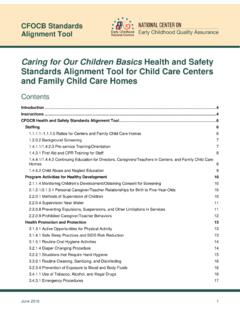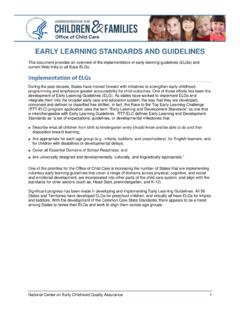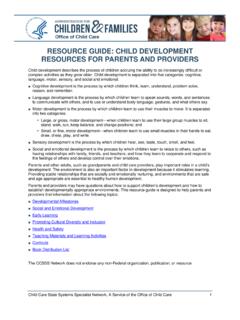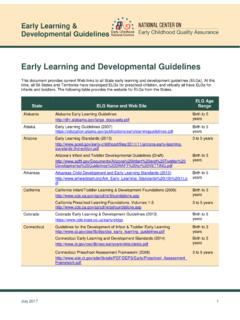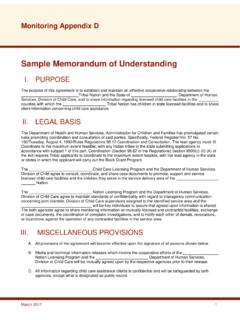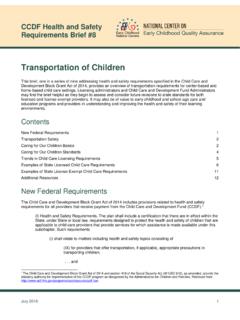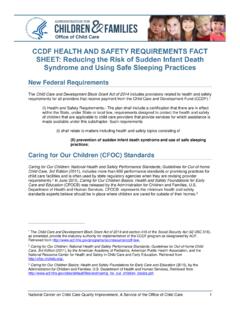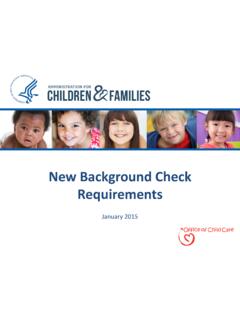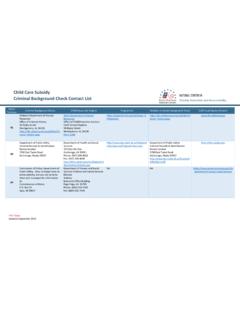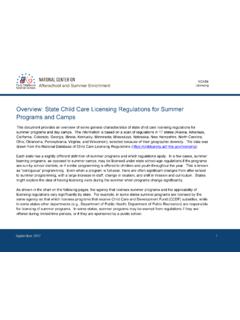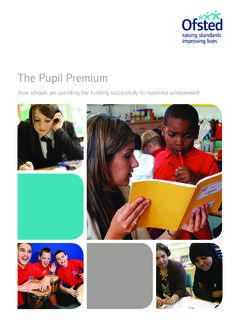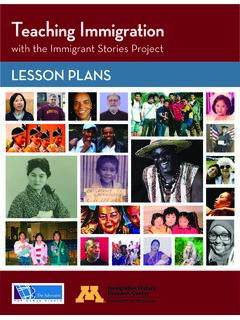Transcription of Reducing the Risk of Sudden Infant Death Syndrome and ...
1 CCDF Health and Safety Requirements Brief #4 July 2016 1 Reducing the Risk of Sudden Infant Death Syndrome and Using Safe Sleeping Practices This brief, one in a series of nine addressing health and safety requirements specified in the Child Care and Development Block Grant Act of 2014, provides an overview of Reducing the risk of Sudden Infant Death Syndrome (SIDS) and using safe sleeping practices for center-based and home-based child care settings. Licensing administrators and Child Care and Development Fund Administrators may find the brief helpful as they begin to assess and consider future revisions to state standards for both licensed and license-exempt providers. It may also be of value to early childhood and school-age care and education programs and providers in understanding and improving the health and safety of their learning environments. Contents New Federal Requirements 1 Caring for Our Children basics 2 Caring for Our Children Standards 3 Trends in Child Care Licensing Requirements 3 Examples of State Licensed Child Care Requirements 4 Examples of State License-Exempt Child Care Requirements 8 Additional Resources 12 New Federal Requirements The Child Care and Development Block Grant Act of 2014 includes provisions related to health and safety requirements for all providers that receive payment from the Child Care and Development Fund (CCDF).
2 1 (I) Health and Safety Requirements. The plan shall include a certification that there are in effect within the State, under State or local law, requirements designed to protect the health and safety of children that are applicable to child care providers that provide services for which assistance is made available under this subchapter. Such requirements (i) shall relate to matters including health and safety topics consisting of (II) prevention of Sudden Infant Death Syndrome and use of safe sleeping practices; .., and 1 The Child Care and Development Block Grant Act of 2014 and section 418 of the Social Security Act (42 USC 618), as amended, provide the statutory authority for implementation of the CCDF program as designated by the Administration for Children and Families. Retrieved from Preventing Sudden Infant Death Syndrome July 2016 2 (XI) minimum health and safety training, to be completed pre-service or during an orientation period in addition to ongoing training, appropriate to the provider setting involved that addresses each of the requirements relating to matters described in subclauses (I) through (X); Caring for Our Children basics Released in 2015 by the Administration for Children and Families, Caring for Our Children basics : Health and Safety Foundations for Early Care and Education (CFOCB) represents the minimum health and safety standards experts believe should be in place where children are cared for outside their CFOCB seeks to reduce conflicts and redundancies found in program standards linked to multiple funding streams.
3 Though voluntary, ACF hopes CFOCB will be a helpful resource for States and other entities as they work to improve health and safety standards in licensing and quality rating and improvement systems. The following standards from CFOCB address Reducing the risk of Sudden Infant Death Syndrome and the use of safe sleep practices. Pre-service Training/Orientation Before or during the first three months of employment, training and orientation should detail health and safety issues for early care and education settings including, but not limited to, typical and atypical child development; pediatric first aid and CPR; safe sleep practices, including risk reduction of Sudden Infant Death Syndrome / Sudden Unexplained Infant Death (SIDS/SUID); poison prevention; shaken baby Syndrome and abusive head trauma; standard precautions; emergency preparedness; nutrition and age-appropriate feeding; medication administration; and care plan implementation for children with special health care needs.
4 Caregivers/teachers should complete training before administering medication to children. See Standard for more information. All directors or program administrators and caregivers/teachers should document receipt of training. Providers should not care for children unsupervised until they have completed training in pediatric first aid and CPR; safe sleep practices, including risk reduction of Sudden Infant Death Syndrome / Sudden Unexplained Infant Death (SIDS/SUID); standard precautions for the prevention of communicable disease; poison prevention; and shaken baby Syndrome /abusive head trauma. Safe Sleep Practices and SIDS Risk Reduction All staff, parents/guardians, volunteers, and others who care for infants in the early care and education setting should follow safe sleep practices as recommended by the American Academy of Pediatrics (AAP). Cribs must be in compliance with current Consumer Product Safety Commission (CPSC) and ASTM International safety standards.
5 See Standard for more information. Cribs and Play Yards Before purchase and use, cribs and play yards should be in compliance with current CPSC and ASTM International safety standards that include ASTM F1169-10a Standard Consumer Safety Specification for Full-Size Baby Cribs, ASTM F406-13, Standard Consumer Safety Specification for Non-Full-Size Baby Cribs/Play Yards, or the CPSC 16 CFR 1219, 1220, and 1500 Safety Standards for Full-Size Baby Cribs and Non-Full-Size Baby Cribs; Final Rule. Programs should only use cribs for sleep purposes and ensure that each crib is a safe sleep environment as defined by the American Academy of Pediatrics. Each crib should be labeled and used for the Infant s exclusive use. Cribs and mattresses should be thoroughly cleaned and sanitized before assignment for 2 Administration for Children and Families, Department of Health and Human Services. (2015). Caring for our children basics : Health and safety foundations for earl y care and education.
6 Retrieved from Preventing Sudden Infant Death Syndrome July 2016 3 use by another child. Infants should not be placed in the cribs with items that could pose a strangulation or suffocation risk. Cribs should be placed away from window blinds or draperies. Caring for Our Children Standards Caring for Our Children: National Health and Safety Performance Standards; Guidelines for Early Care and Education Programs, 3rd edition (CFOC3), is a collection of 686 national standards that represent best practices with respect to health and safety in early care and education settings. CFOC3 can help programs and providers implement CFOCB, understand rationale, and move to higher levels of quality in health and safety. CFOC3 is available at The following links to CFOC3 pertain to the prevention of Sudden Infant Death Syndrome and use of safe sleeping practices. The links go to the full text of the standard, with a rationale supported by research. Standard : Safe Sleep Practices and SIDS/Suffocation Risk Reduction A compilation of CFOC standards about safe sleep practices and SIDS/suffocation risk reduction is available at Trends in Child Care Licensing Requirements The following table provides information about the number of States4 that have requirements for safe sleep practices and SIDS prevention in their licensing regulations for child care centers5, family child care (FCC) homes6, and group child care (GCC) According to licensing regulations from 2014, most States require providers to place infants on their backs to sleep.
7 The inclusion of this requirement has increased significantly in the last decade. The number of States that prohibit soft bedding in cribs and require specific training in safe sleep practices has also increased. 3 American Academy of Pediatrics, American Public Health Association, & National Resource Center for Health and Safety in Child Care and Early Education. (2011). Caring for our children: National health and safety performance standards; Guidelines for early care and education programs, 3rd edition. Retrieved from 4 States includes the 50 States, the District of Columbia, and 2 Territories Guam and the Virgin Islands. 5 National Center on Early Childhood Quality Assurance. (2015). Research brief #1: Trends in child care center licensing regulations and policies for 2014. Retrieved from 6 National Center on Early Childhood Quality Assurance. (2015). Research brief #2: Trends in family child care home licensing regulations and policies for 2014.
8 Retrieved from 7 National Center on Early Childhood Quality Assurance. (2015). Research brief #3: Trends in group child care home licensing regulations and policies for 2014. Retrieved from Preventing Sudden Infant Death Syndrome July 2016 4 Number of States With SIDS Prevention Requirements in Licensing Regulations in 2014 Licensing Requirements Child Care Centers (N = 53) FCC Homes (N = 46) GCC Homes (N = 40) Infants must be placed on their backs to sleep 47 39 33 Physicians may authorize different sleep positions for infants 38 35 29 Parents can authorize different sleep positions for infants 6 3 1 Soft bedding/materials must not be used in cribs 30 26 20 Facilities must use cribs that meet the Consumer Product Safety Commission requirements 15 19 17 Staff/providers are required to complete training about SIDS prevention 28 17 14 N = The number of States that regulate the type of facility. Examples of State Licensed Child Care Requirements Licensing of center-based care and family child care homes is a process that establishes the minimum requirements necessary to protect the health and safety of children in care.
9 State licensing requirements are regulatory requirements, including registration or certification requirements, that State law establishes as necessary for providers to legally operate and provide child care The following excerpts, related to the prevention of Sudden Infant Death Syndrome and use of safe sleeping practices, are from licensing requirements in Florida, Georgia, Texas, and Washington. These examples do not include all States that have these requirements, but are meant to represent a range of approaches States have taken in their regulations. A document with links to all States child care licensing regulations is available at Child Care Center Requirements Texas Minimum Standards for Child-Care Centers, Chapter 746, Title 40, Social Services & Assistance, Part 19 (June 2015), Are specific types of equipment prohibited for use with infants? Yes. The following list of equipment, identified as unsafe for infants by the Consumer Product Safety Commission and the American Academy of Pediatrics, must not be used in the child-care center: (1) Baby walkers; (2) Baby bungee jumpers; 8 Administration for Children and Families, Department of Health and Human Services.
10 (2015). Caring for our children basics : Health and safety foundations for early care and education. Retrieved from Preventing Sudden Infant Death Syndrome July 2016 5 (3) Accordion safety gates; (4) Toys that are not large enough to prevent swallowing or choking; (5) Bean bags, waterbeds, and foam pads for use as sleeping equipment; and (6) Soft or loose bedding such as blankets, sleep positioning devices, stuffed toys, quilts, pillows, bumper pads, and comforters must not be used in cribs for children younger than 12 months of age. Are infants required to sleep on their backs? Infants not yet able to turn over on their own must be placed in a face-up sleeping position, unless the child s parent presents written documentation from a health-care professional stating that a different sleeping position is allowed or will not harm the Infant . May I swaddle an Infant to help the Infant sleep? No. You may not lay a swaddled Infant down to sleep or rest on any surface at any time.
